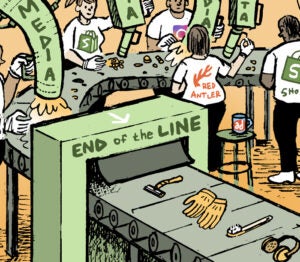Here’s today’s AdExchanger.com news round-up… Want it by email? Sign up here.
Remember Oath?
Verizon Media Group, the company formerly known as Oath, is shrinking as the telco shifts its focus and most of its resources to 5G. The media group, which is made up of Verizon’s acquisition and merger of AOL and Yahoo, saw revenues decline 7.2% in Q1 to $1.8 billion. To be fair, that’s still a sizeable chunk of change, but Verizon Media Group’s performance is lackluster given the hype when it burst onto the digital ad market in 2017. “Declines in desktop advertising continue to more than offset growth in mobile and native,” said Verizon chief financial officer Matthew Ellis. But Verizon Media Group did manage to integrate its DSP and SSP into a consolidated stack. The telco also lost 44,000 paid phone subscribers and 53,000 FiOS subscribers last quarter as a result of cord cutting and competition. Read the release.
Money Talks
Financial services brands are upping their social media spend. Capital One dropped $18.6 million on Facebook ads last year and American Express spent $13.5 million, an increase of $2.8 million and $4 million, respectively, according to the ad analytics company Pathmatics. Credit card companies are investing in influencer marketing on Twitter and Instagram, where well-followed users drive sign-ups by posting photos confirming reward program benefits. Financial companies need to balance landing new consumers against the risk of being gamed for early reward point and then canceled, The Wall Street Journal reports. Younger digital finance brands like Venmo and PayPal, or Apple’s partnership with Goldman Sachs on a phone-linked credit card, are relatively bigger spenders online. Credit card companies still spend almost half of their marketing budgets on direct mail. More.
Debt Of Gratitude
Netflix is raising $2 billion in debt for purposes that “may include content acquisitions, production and development, capital expenditures, investments, working capital and potential acquisitions and strategic transactions.” Read the release. It’s only been half a year since the company’s last debt financing round, which was also $2 billion. But the streaming landscape has changed in those six months. Disney unveiled its $6.99 per month subscription service, Disney+, and studios like WarnerMedia and NBCUniversal are also pulling content from Netflix for their own offerings. Those deep-pocketed competitors also increase Netflix’s marketing costs by churning subscribers and bidding up the same audiences. Netflix said 2019 should see the peak of its cash burn, CNBC reports. If and when Netflix begins to experiment with ads or sponsorship options, it may be a concession to the company’s debt.
But Wait, There’s More!
- Ecommerce Is Upending Madison Avenue – Axios
- Pandora Adds SiriusXM Talk Shows As Podcasts – Engadget
- Fuse Media Files For Bankruptcy As Subscriber Losses Mount – Bloomberg
- Connected TV Advertising And CPMs Are Rising – MediaPost
- Customer Data And Ad Tech Startup Blueshift Raises $15M – release
- MDC Resolves Investor Dispute As Mark Penn Becomes Chairman – Adweek
- Verizon Partners With Google To Include YouTube TV With Subscriptions – release
- Programmatic Advertisers Ramp Up Efforts To Deal Directly With Pubs – Digiday
- Ad Buyers Usually Pay More Than $20 For Connected TV CPMs – eMarketer
- The Podcast Monetization Wars Are Heating Up – The Verge
- Google Adds More Hotel Search Features – Skift
You’re Hired!
- Group Nine Hires Brian Lee To Lead Its Commerce Business – TechCrunch
- Facebook Hires Top State Dept Lawyer, Bill Gates’ Former PR Chief – WSJ
- Former Epsilon And Zeta Interactive CMO Joins N6A As CRO – release
- Axios Hires Emily Allen To Lead Branded Content Studio – MediaPost












